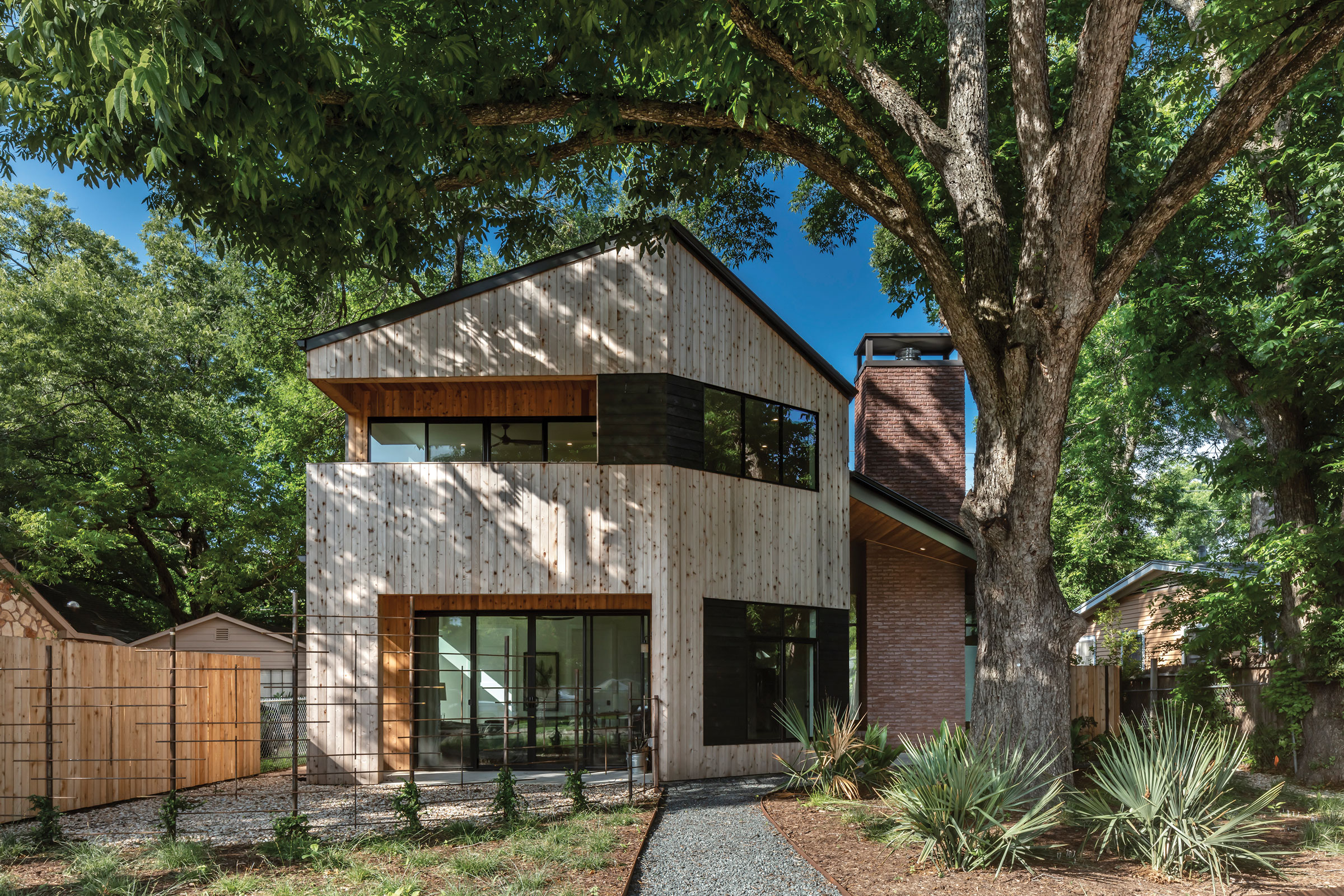Story at a glance:
- An ADU—or accessory dwelling unit—is a small self-contained secondary housing unit located on the same property as a single-family residence.
- Sustainable ADU design prioritizes the use of green building materials, passive design strategies, renewable energy, energy- and water-efficient systems, and more.
- ADU laws and regulations vary considerably at the state and municipal level but are becoming increasingly streamlined as the popularity of ADUs grows.
An estimated 1.4 million legal accessory dwelling units—or ADUs—exist in the United States, with that number growing steadily larger each year. Housing experts, real estate agents, and urban planners alike have posited that this rise in ADU popularity could be crucial in helping to solve the affordable housing crisis.
But like any new building, it’s important that these accessory units are designed in a manner that minimizes their environmental impact. In this article we’ll provide a basic overview of ADUs, their benefits, and what to know before building one, plus provide some insight as to how they may be designed with sustainability in mind.
What is an ADU?
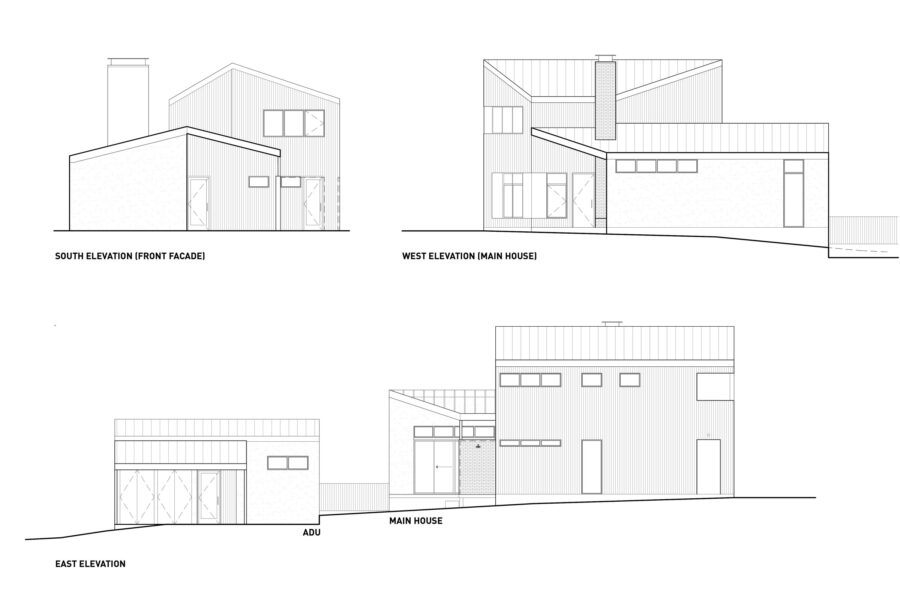
Hewn House, with ADU. Drawing courtesy of Matt Fajkus Architecture
An accessory dwelling unit—otherwise known as an ADU—is a small, self-contained secondary housing unit located on the same lot as a stand-alone single-family residence. These units generally possess their own separate entrance, living area, kitchen, and bathroom as opposed to sharing amenities with the main residence, but certain ADU configurations may feature shared spaces.
Most ADUs measure between 600 and 1,200 square feet, making them ideal for smaller households.
Types of ADUs
There are three broad categories of ADUs, characterized in large part by their relationship to the primary residence:
- Interior. Interior ADUs are located within a primary residence but still function independently, possessing their own entryway, kitchen, and bathroom; interior ADUs are often converted from existing spaces—e.g attics, basements, garages, et cetera—and are rarely built into new construction.
- Attached. An attached ADU is usually built as a pop-out that shares at least one wall with the primary residence; attached ADUs are typically added to the property at a later date than the original home.
- Detached. A detached ADU exists as a separate, free-standing building that shares no walls with the main residence; detached ADUs are comparable to tiny homes and may be built in conjunction with the primary residence or at a later date.
Benefits of ADUs
ADUs offer a range of economic, social, and environmental benefits:
Economic
One of the most appealing qualities of an ADU is the ability to rent it out to generate secondary or supplemental income. It’s estimated that roughly 50% of the people building ADUs are doing so with the intention of renting them to tenants. This alternative stream of income can help homeowners offset their mortgage and maintenance payments, ultimately making homeownership a more affordable prospect.
Adding an ADU can also help improve ROI and increase the overall value of a property—potentially by as much as 35%, according to a study conducted by the National Association of Realtors.
Constructing ADUs is also a relatively easy way to integrate affordable workforce housing into existing single-family neighborhoods without impacting either their scale or character, which can in turn benefit municipal budgets by increasing the amount of taxable housing without having to drastically expand existing infrastructure.
Social
ADUs also offer social benefits by supporting the growth of diverse and multi-generational households, providing aging parents, adult children, or other relatives with affordable housing options closer to their families. ADUs are particularly useful in allowing seniors to “age in place” within their own neighborhoods, an arrangement that can help seniors maintain autonomy and independence, improve their social lives, and put them closer to relatives capable of providing care if necessary.
Environmental
Because of their smaller size, location on existing residential lots, and reliance on existing municipalities, ADUs are considered to be an environmentally sustainable means of increasing housing stock, as their construction does not necessitate outward urban expansion and requires fewer materials.
It is also incredibly easy to construct energy-efficient ADUs that use significantly less energy for heating and cooling than conventional single-family homes, resulting in fewer emissions and reduced operating costs.
What Makes an ADU Sustainable?
Many of the elements that might be used to sustainably design a conventional residence may be implemented when designing an ADU, especially those of the attached and detached varieties that are built from the ground-up.
Some of these strategies include:
Green Building Materials
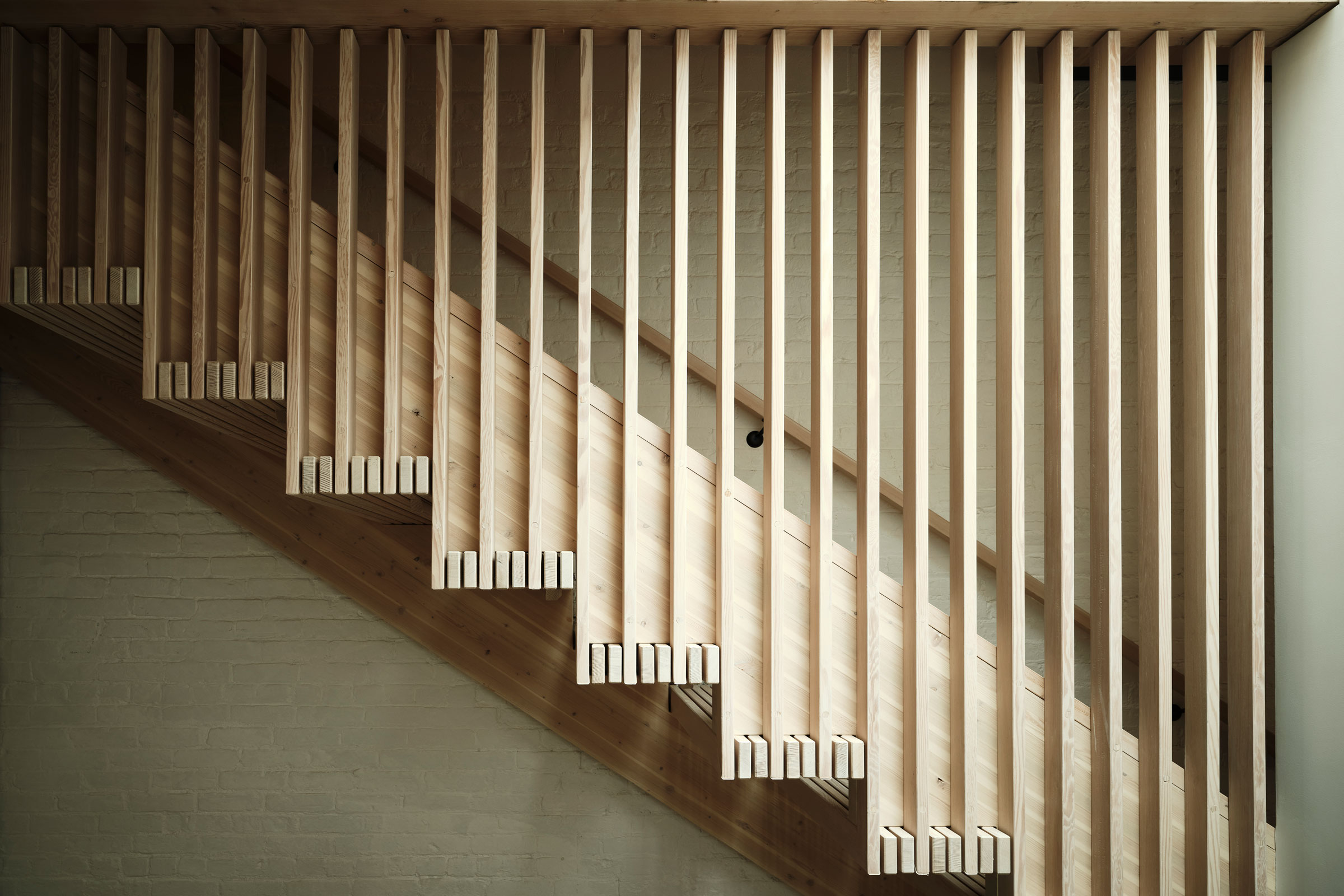
Glue-laminated Douglas fir was used to form this central stairwell. Photo by Frank Frances
A determining factor in any building’s overall sustainability is the materials used in its construction. Wherever possible, green building materials like wood, mass timber, bamboo, stone, brick, and reclaimed/recycled materials should be used when designing an ADU in order to reduce its environmental impact and embodied carbon.
Building with green materials also means building with healthy materials—that is, materials that won’t leach toxic chemicals or off-gas VOCs over the course of their operational lifespan and after they have been disposed of. One of the simplest ways to verify that a building material or product does not contain harmful ingredients is to look for a Red List-free label.
Curated by the International Living Future Institute, the Red List is a comprehensive guide to the “worst in class” materials, chemicals, and elements known to cause serious harm to human and ecosystem health. Products bearing the Red List-free label fully disclose 100% of their ingredients measured at or above 100 ppm in the final product and do not contain any chemicals on the Red List.
Use of Prefabrication Technology
Because of their limited footprint and smaller size, attached and detached ADUs are extremely well-suited to the use of prefabrication technology in their designs. Prefabrication describes the process by which all or a portion of a building is manufactured in an off-site factory before being assembled and transported to, or transported and assembled on, the build site.
The controlled environment in which prefab components are designed and manufactured produces far less waste than conventional construction methods, allowing for more precise designs that ultimately end up being more airtight and energy-efficient than traditional stick-built homes.
Renewable Energy Integration
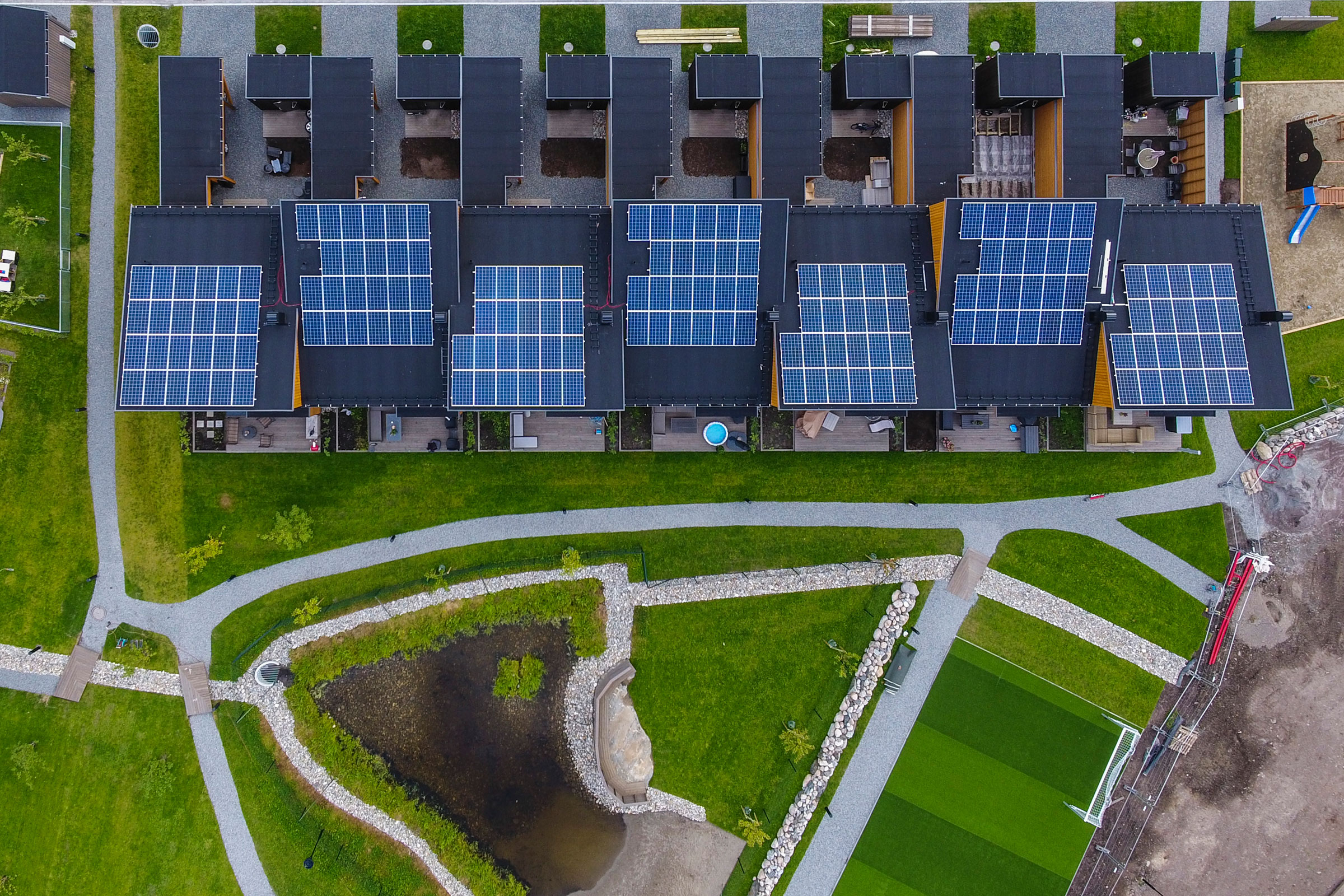
Otovo helps home owners find the best price and installer for solar panels, all without a home visit. Photo courtesy of Otovo
ADUs can also be outfitted with renewable energy technologies to help reduce their carbon footprint and the housing market’s overall dependence on fossil fuels. Solar and photovoltaic panels, for example, produce 12 times fewer CO2 emissions than natural gas and can help save households approximately $1,500 a year on their electricity bills.
Both solar and PV panels are becoming more and more affordable options, with state and federal governments offering assistance programs and tax incentives for their installment. A full guide to energy-related federal financial assistance programs can be found on the DOE’s website.
And while solar power is often the easiest form of renewable energy to integrate into ADU design, it is by no means the only option. Geothermal heat pumps are also becoming increasingly common in residential projects and can reduce energy bills by as much as 72% compared to standard air conditioning units, according to the DOE.
Daylighting & LED Lighting
Daylighting describes the process of using windows, skylights, and other light-admitting features to illuminate a building’s interior with natural sunlight throughout the day. By using windows, skylights, reflective surfaces, and other light-admitting features, daylighting can make effective use of indirect or direct sunlight to reduce an ADU’s energy loads and utility bills by anywhere from 20 to 60%.
Supplementary artificial lighting installed in an ADU should make use of LEDs, as these operate up to 90% more efficiently and have much longer lifespans than both traditional fluorescent and incandescent bulbs, reducing waste and maintenance requirements.
Energy-Efficient Fenestration
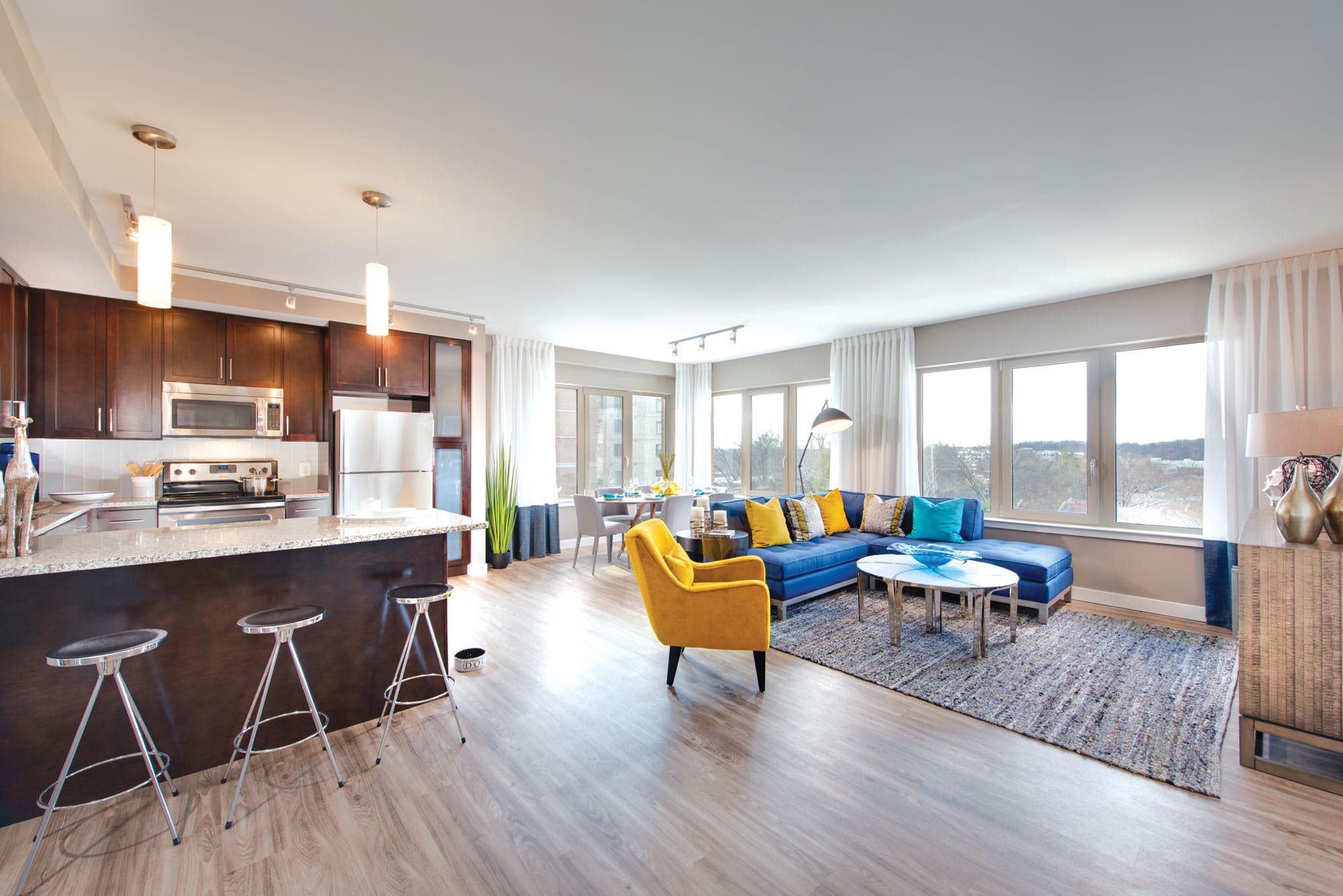
Installing REHAU windows can make any building more energy-efficient and comfortable. Photo courtesy of REHAU
Approximately 30% of a home’s heating and cooling energy is lost through its windows and doors. For this reason, sustainable ADU design necessitates the use of energy-efficient fenestration, or windows and doors that drastically reduce energy waste through their improved insulative and air-sealing capabilities.
Energy-Efficient Windows
Energy-efficient windows—identifiable by their ENERGY STAR label—feature a frame material with high thermal resistance (such as fiberglass), high-quality weather-stripping for improved sealing, and either dual- or triple-paned glass that contains inert argon gas between the layers for additional insulation.
To reduce solar heat gain and block UV rays from entering an ADU, energy-efficient windows typically employ a low-emissivity coating or film that uses microscopic metal fragments to reflect solar energy.
Energy-Efficient Doors
While not all ADUs possess exterior-facing doors, those that do can prevent energy waste by installing energy-efficient doors. Energy-efficient doors are specifically designed to prevent excess heat from entering a building in the summer and escaping in the winter through the use of materials and techniques that effectively seal air leaks and improve insulation.
When installed correctly, energy-efficient doors can help ADUs save energy and reduce their operating costs, potentially by as much as 12%.
Energy Recovery Ventilators
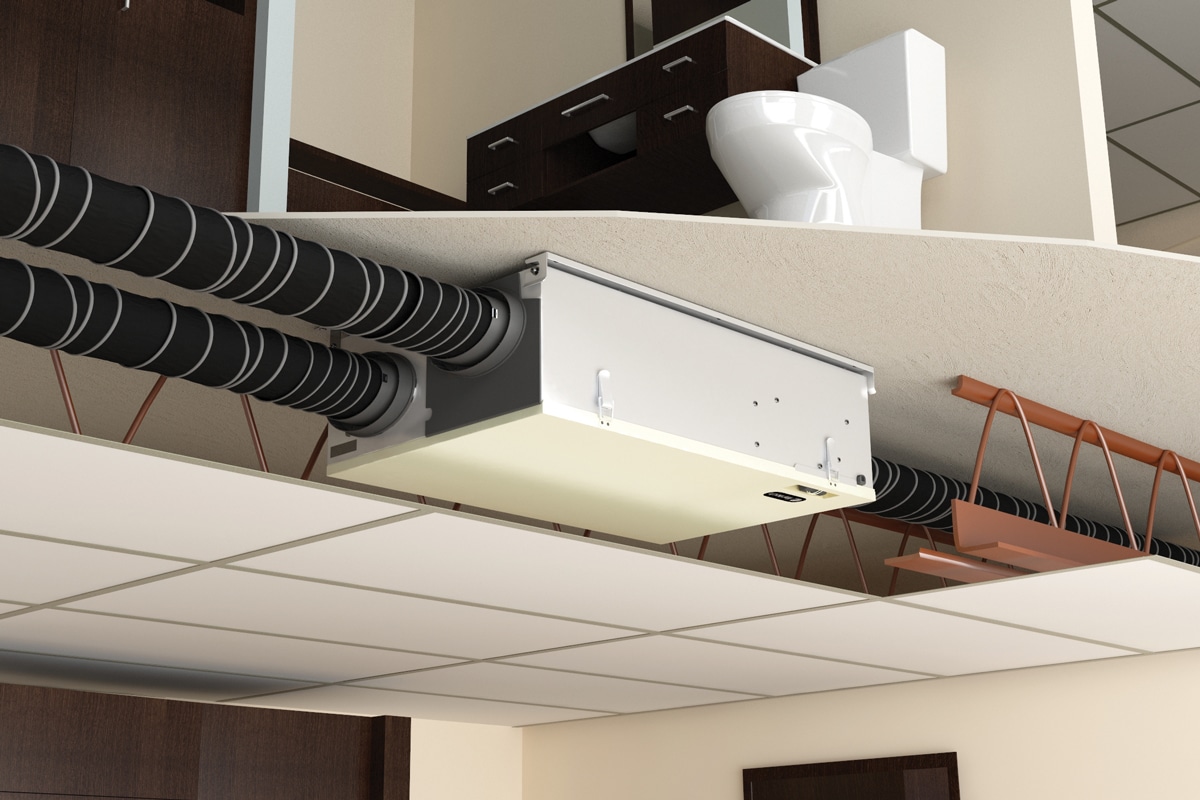
Photo courtesy of Fantech
Another way for ADUs to reduce their energy consumption and improve their overall sustainability is through the installation of an energy recovery ventilator.
Energy recovery ventilation (ERV) systems are incredibly efficient and are capable of recovering anywhere from 60 to 95% of the heat from incoming or outgoing air. During warmer months an ERV unit will recover heat from the incoming air and direct it back outside, dehumidifying the air in the process; in winter an ERV recovers heat from the outgoing air and reuses it to help warm the incoming air, which is then humidified before it is circulated.
Water-Efficient Fixtures & Appliances
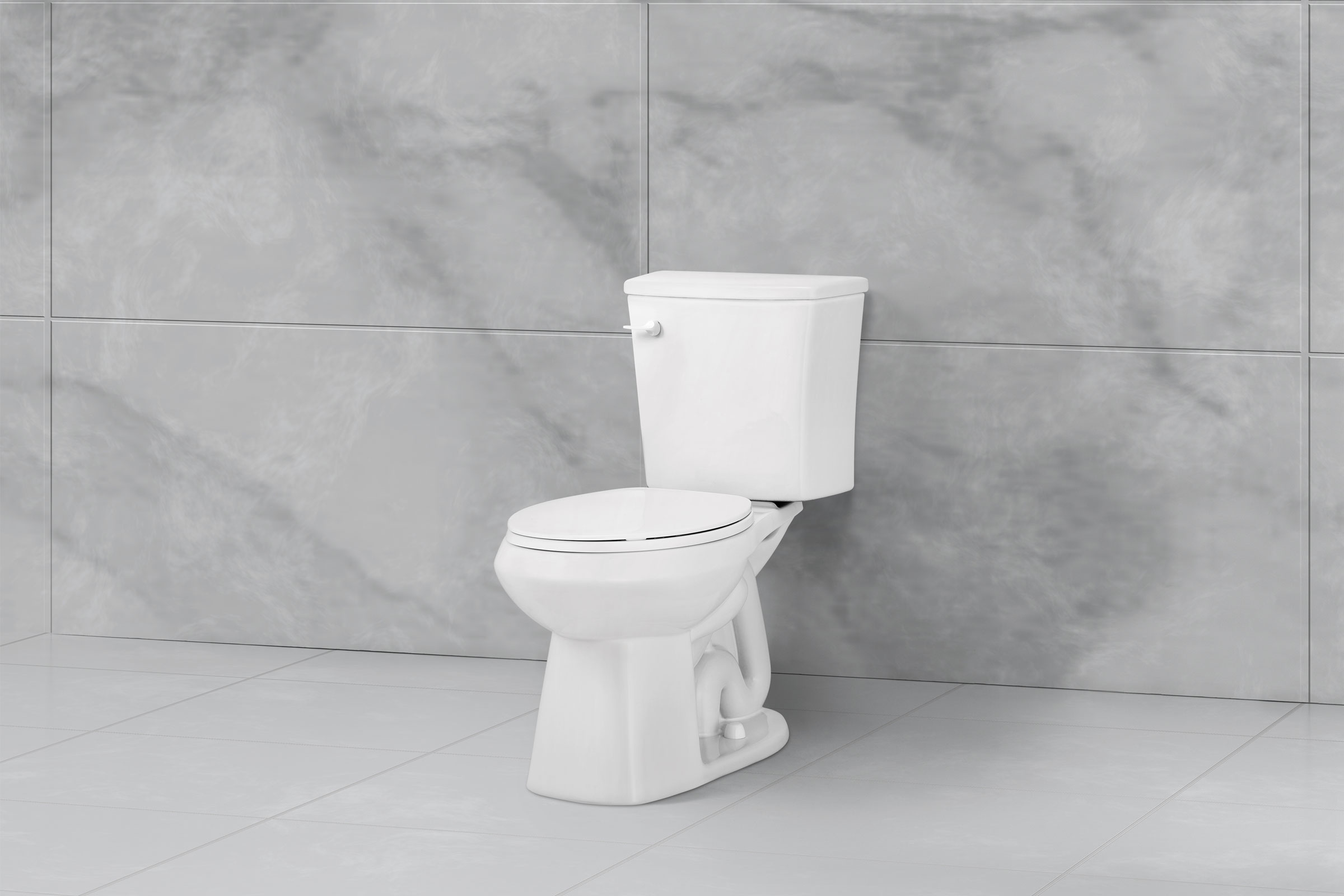
The type of toilet you choose contributes greatly to a project’s overall water efficiency. Photo courtesy of Niagara
An ADU can also be made sustainable through the use of water-efficient fixtures and appliances. The EPA estimates that the average household wastes 180 gallons of water per week—and while most ADUs naturally use less water than the average single-family residence by virtue of being smaller and home to fewer residents, that doesn’t mean there isn’t room for improvement.
Three of the most significant areas for water conservation in ADU design are toilets, showerheads, and sink faucets; combined, these fixtures account for roughly 66% of a home’s water usage. Installing WaterSense or low-flow versions of these fixtures can drastically reduce an ADU’s overall water consumption.
Low-Flow Toilets
Estimates suggest that toilets account for roughly 30% of a household’s daily water consumption, according to the EPA. In compliance with federal law, all toilets are required to use no more than 1.6 gallons of water per flush, but ultra low-flow toilets—like those produced by Niagara—use even less at only 1.28 gallons per flush.
Ultra-efficient low-flow toilets can be recognized by their WaterSense certification, which denotes that they have successfully completed stringent independent laboratory testing with regard to performance and efficiency.
Low-Flow Shower Heads
Standard shower heads typically use 2.5 gallons of water per minute, but you may be consuming far more depending on the kind of shower system you have installed (such as one with several showerheads). Showerheads with the WaterSense low-flow seal of approval, however, use no more than 2 gallons of water per minute. Once installed it’s estimated that these fixtures can help household’s save 2,700 gallons annually.
Low-Flow Faucets
According to the EPA the standard flow rate of most faucets is 2.2 gallons per minute (GPM), which is generally more water than most sinks require—and while sink faucets typically consume the least water out of all a building’s plumbing fixtures, there is still room for improvement in terms of their water usage.
High-efficiency WaterSense-certified faucets, for example, reduce a sink’s water flow by at least 30%, bumping the flow rate down to 1.5 GPM or lower without sacrificing performance (adequate water pressure) in the process. Faucet efficiency can also be improved through the addition of a WaterSense-certified aerator, a type of screw-on faucet accessory that mixes air into the flow of water, thereby reducing the amount that actually passes through the tap.
Green Plumbing Solutions
Besides installing water-efficient fixtures and appliances, ADU’s can reduce their water consumption and waste through the use of several other green plumbing solutions, including:
Pressure-Reducing Valves
ADUs—especially those connected to municipal water lines—can help conserve water through the installation of pressure-reducing valves. A pressure-reducing valve automatically reduces the high unregulated pressure of incoming water to a lower, constant pressure that is better suited to residential use.
In reducing water pressure pressure-reducing valves lower the rate of flow, resulting in less water being used to accomplish the same tasks. Lowering incoming water pressure by as little as 10 to 20 psi can save the average ADU thousands of gallons each year, further reducing their already low operation costs.
Recirculating Hot Water Pump
Most residential households—including ADUs—use a one-way plumbing system in which hot water is pumped from a water heater and delivered to the appropriate appliance or fixture. Once that fixture is shut off, however, any excess hot water still in the pipes remains there and cools down over time, resulting in a warm-up period the next time the fixture is turned on. All of the cool, static water in the pipe is subsequently wasted in the wait for warm water.
Installing a recirculating hot-water pump eliminates this wait time and prevents water/energy waste by circulating water through the cooled pipes from the heater to the farthest fixture before recirculating said water back to the heater via the cool-water line. Such a system delivers hot water instantly, eliminates static water waste, and uses less energy than operating a 25-watt light bulb.
What to Know Before Building an ADU
Building or converting an existing space into an ADU, however, isn’t as simple as building a conventional single-family residence—at least, not usually. In the US ADU zoning permissions and laws vary widely by state and municipality. Some areas might allow ADUs with certain stipulations, such as that the residents must be related to the property owner or that additional parking must be added. Some municipalities may be generally favorable to ADUs, but might not allow them to be built in historic districts.
There are also certain cities and localities that expressly prohibit the building of ADUs outright, often based on the opinion that such units would reduce property values, create parking issues, or impact the existing character of the neighborhood.
As a whole, however, most states have started to recognize the potential benefits of ADUs and have begun working to streamline the permit and construction processes. California, for example, has some of the most lenient ADU laws in that nation and has passed bills limiting the authority of local governments to prohibit ADUs, as well as reducing the bureaucracy and cost hurdles involved in their construction.
All in all, it is important that prospective ADU owners check with their local zoning board and understand all applicable building code requirements before designing and building an ADU. Homeowners who are part of an HOA should also verify whether ADUs are permissible in their neighborhood or if they are subject to any further design requirements.

